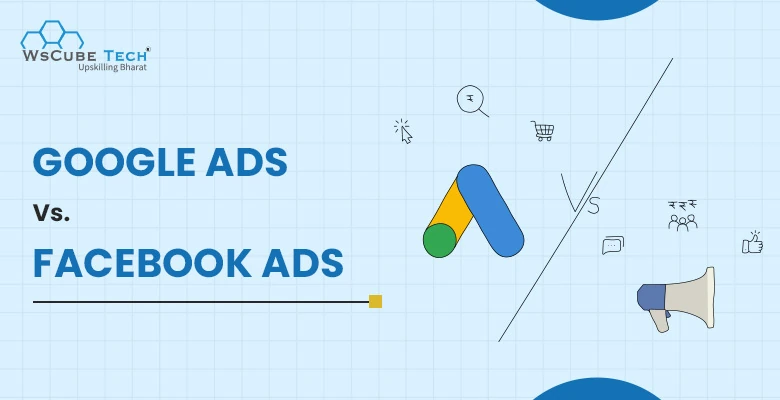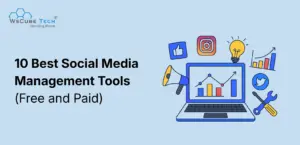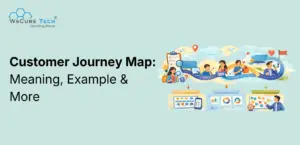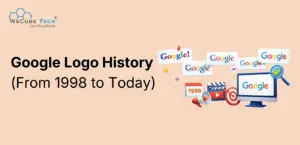Choosing the right advertising platform between Google Ads versus Facebook Ads can significantly impact your business's online marketing success. Both platforms offer robust targeting and extensive reach but serve different purposes and audiences. Google Ads vs. Facebook Ads—which is best for your marketing strategy in 2025? Google Ads, operating through search engine queries, excels in capturing demand by targeting specific keywords related to user searches.
This makes it ideal for businesses looking to connect with customers who intend to purchase or find a specific service. On the other hand, Facebook excels in creating demand. It utilizes user demographic and interest-based targeting to reach target customers who may not be actively searching but are likely interested in your products.
Understanding the strengths and applications of Google vs fb ads is crucial in deciding where to allocate your advertising budget for optimal results.
What Are Google Ads?
Google Ads, earlier known as Google AdWords, is a powerful and widely-used online advertising platform that businesses use to display ads on Google's search engine results pages and across its network. This platform operates on a pay-per-click (PPC) model, where advertisers pay a certain amount each time users click on their ads.
The strength of Google Ads lies in its ability to target users actively searching for specific products and services, offering timely ads that match their immediate needs. This makes it highly effective for driving direct traffic and conversions. Businesses can use Google Ads to reach potential customers when they express interest in what the business offers, making it a vital tool for many digital marketing strategies. To learn more about Google Ads and how to optimize them for better results, join our Performance marketing course now.
What Are Facebook Ads?
Facebook Ads is an effective online advertising platform that businesses use to target buyers and users based on their demographics, interests, and behavior on Facebook. This tool is part of Facebook's broader advertising ecosystem, which includes Instagram and other affiliated sites. Unlike Google Ads, which targets users based on their search queries, Facebook Ads help you tap into potential customers by showcasing your ads to users who may be interested in your products or services, even if they aren't actively searching for them.
This makes Facebook Ads effective for building brand awareness and capturing interest. Moreover, it offers a variety of ad formats like images, videos, slideshows, and more, making it a versatile option for creative marketing strategies.

Differences Between Facebook Ads and Google Ads
When comparing Google vs Facebook advertising, it's crucial to understand the differences and similarities each platform offers advertisers.
1. Targeting Approach:
Google Ads primarily targets users based on their search queries, making it highly effective for capturing demand when users actively seek specific products or services. Facebook Ads target based on user demographics, interests, and online behavior, making it ideal for creating demand and brand awareness among users who may not be actively searching for something specific.
2. Ad Placement:
Google Ads appear on Google Search results pages, other Google properties like YouTube, and websites within the Google Display Network. Facebook Ads appear across the Facebook platform, including Instagram, Messenger, and the Audience Network, and reach people while they're on different websites and apps.
3. Intent vs. Interest:
Google Ads is intent-based, catching users when they express an interest through a search query. Facebook Ads is interest-based, allowing advertisers to reach users based on their profile information and engagement patterns, even before they show explicit intent.
4. Ad Formats:
Google provides a variety of ad formats, including text ads, shopping ads, and display ads, but they are typically more straightforward and text-based. Facebook offers creative formats like images, videos, carousels, and interactive ads, providing more creative flexibility.
Similarities Between Google Ads and Facebook Ads
1. Pay-Per-Click Model:
Both platforms operate on a pay-per-click (PPC) method, where advertisers pay a certain amount when users click on their ad.
2. Extensive Reach:
Both platforms have a massive global reach, with billions of users on Google and Facebook, allowing advertisers to reach a vast audience.
3. Advanced Tracking:
Both Google Ad and Facebook Ad offer advanced tracking capabilities for measuring campaign performance, including click-through rates, conversion rates, and detailed insights about the audience.
4. Optimization Tools:
Both platforms provide tools and features for optimizing ads, such as A/B testing, automated bidding, and adjustments based on device, time, and location, to enhance campaign effectiveness.
5. Customizable Budgets:
Advertisers can set and adjust their budgets on both platforms, controlling how much they spend daily or per campaign, making it accessible for businesses of all sizes.
Understanding these differences and similarities can help advertisers decide whether Google ads or Facebook ads are better, or a combination of both can best meet their marketing objectives. Whether it's Google Ads vs. Facebook Ads for dropshipping or deciding which has a better conversion rate, the choice depends on the campaign's specific goals and target audience.
Benefits of Facebook Ads
Facebook Ads offer a variety of benefits that make them a competitive choice for online advertising. Here's a breakdown of some key advantages:
1. Extensive Targeting Options:
Facebook allows advertisers to target users based on their age, location, interests, behaviors, and more. This deep level of granularity enables businesses to reach specific demographics, making the ads more relevant and effective.
2. Visual Appeal:
Facebook is a visually oriented platform, and its ads support various formats, including video, photo, slideshow, carousel, and stories. This variety helps capture users' attention more effectively than traditional text-based ads.
3. User Engagement:
Facebook's environment encourages interaction through likes, comments, and shares. Ads that engage users can benefit from increased visibility and organic reach as they are shared among friends and followers.
4. Integration with Instagram:
Facebook owns Instagram, so advertisers can easily place ads on both social media platforms simultaneously through the same interface. This integration provides a broader reach and consolidates ad management.
5. Retargeting Capabilities:
Facebook excels in retargeting, allowing businesses to serve targeted ads to users who have previously interacted with their website or app. This is crucial for converting initial interest into sales.
6. Insightful Analytics:
Facebook provides comprehensive analytics that helps advertisers track campaigns, their performances and effectiveness. Metrics such as reach, clicks, conversions, and sales are readily available, enabling ongoing optimization.
7. Cost-effectiveness:
Facebook Ads can be more budget-friendly than other advertising platforms, especially for small—to medium-sized businesses. Advertisers can set daily or campaign budgets, and the platform offers a cost-per-click pricing model, which means you only pay when someone interacts with your ad.
8. Accessibility:
Creating and launching a Facebook ad campaign is relatively simple, making it accessible even to those with limited marketing experience. Facebook's tools guide users through the setup process, from targeting to choosing ad formats.
9. Mobile-First:
Most Facebook users access the platform via mobile devices, so Facebook Ads are optimized for mobile. This ensures that ads work seamlessly on smartphones and tablets.
Each benefit highlights why Facebook Ads are a strong contender in digital advertising, particularly when comparing Facebook vs Google advertising. Whether for increasing brand awareness, driving website traffic, or boosting sales, Facebook Ads provide a versatile and effective solution for marketers. A full-fledged digital marketer must be proficient in both, so it’s recommended to take up our comprehensive digital marketing course that helps you gain extensive knowledge of both types of ads.
Benefits of Google Ads
Google Ads, formerly known as Google AdWords, offers a plethora of benefits and features,making it an appealing choice for businesses looking to boost their online presence. Here are some of the key advantages:
1. High Intent Targeting:
Google Ads targets users who are actively looking for specific products or services, capturing high intent. This makes it highly effective for driving conversions, as ads are shown to users when they are looking to purchase or obtain a service.
2. Wide Reach:
Google's vast search network allows your ads to be seen by a large audience worldwide. This broad reach is crucial for businesses looking to expand their market or gain exposure in new geographic areas.
3. Measurable Performance:
One of Google Ads' most robust features is its ability to track and measure the performance of your campaigns. You can see how many people viewed your ad, clicked on it, and performed a conversion action like purchasing or signing up for a newsletter.
4. Flexible Budgeting:
Google Ads allows you to set your budget for how much you want to spend per day or campaign. You can also choose a cost-per-click pricing model, which means you only pay when someone clicks on your ad. This makes it cost-effective for businesses of all sizes.
5. Ad Format Variety:
Google Ads offers an array of ad formats, including text ads, display ads, video ads, and more, each designed to cater to different campaign goals and audience engagement strategies.
6. Real-Time Adjustments:
With Google Ads, you can make real-time campaign adjustments. If an ad isn't performing well, you can quickly modify it or redirect your budget to more successful ads, ensuring optimal use of your advertising spend.
7. Advanced Targeting Options:
Besides keyword targeting, Google Ads provides options like location targeting, device targeting, and audience targeting based on previous interactions with your website. This allows for more refined and effective targeting strategies.
Each of these benefits highlights why Google Ads is often considered a powerful tool for digital marketing. Whether driving direct sales or enhancing brand visibility, Google Ads provides a comprehensive platform that aligns with various business objectives.
Expand Your Marketing Skills
Factors to Consider When Choosing Facebook or Google Ads
When deciding between Facebook Ads and Google Ads, you must consider several key factors that determine which platform suits your marketing objectives. Here's a breakdown of these factors:
Objective of the Campaign:
Google Ads are best for reaching users with clear intent. They're ideal for driving conversions like sales or leads, especially when users actively search for specific products or services.
Facebook Ads are preferred for building brand awareness and reaching a broad audience based on interests and demographics. They are also useful for influencing consideration stages by engaging users who might not be actively seeking your product.
Target Audience:
Google Ads target users based on the keywords they type into Google, making it highly effective for reaching people with specific needs or intent.
Facebook ads use detailed demographic and psychographic data to target users, such as age, location, interests, and behavior, which can be more beneficial for demographic-focused campaigns.
Cost:
Google Ads may have a higher CPC. Still, the leads and conversions are often more directly linked to sales, potentially offering a higher return on investment (ROI) for direct response campaigns.
Facebook Ads offer a lower cost-per-click (CPC) than Google Ads. This can make Facebook a more cost-effective option for businesses looking to maximize their reach with a limited budget.
Ad Formats:
Google Ads offers text-based, shopping, and display ads on websites within the Google Display Network. This variety is vital for targeting users at different buying funnel stages.
Facebook Ads provides a variety of creative formats, including images, videos, carousels, slideshows, and more, which can be more engaging and better suited for storytelling.
User Intent:
Google Ads capture high commercial intent, meaning users are often further along in the buying process and more likely to purchase.
Facebook Ads are more about capturing interest and creating demand than fulfilling it, which is ideal for products or services users may not be actively searching for.
Measurement and Analytics:
Both platforms offer robust analytics and measurement tools. Google Ads provides detailed data on user search behavior, while Facebook Ads offers insights into user engagement and demographics.
The choice between them should consider which metrics are most important to your campaign's success: conversion tracking in Google or engagement metrics in Facebook.
Flexibility and Control:
Google Ads allows you to adjust bids, add ad extensions, and optimize based on device, time, and location, which are more directly tied to user searches.
Facebook Ads offer flexibility in adjusting audience targeting parameters and creative testing in a more visual and interactive environment.
The decision of choosing between Google Ads and Facebook Ads should be based on your business goals, budget constraints, target audience, and desired outcome of your advertising efforts. Both platforms have strengths and can be highly effective when aligned with the right marketing strategies.
How to Track Your PPC Results?
Tracking your PPC (Pay-Per-Click) results effectively is crucial for measuring the success of your online ad campaigns and efforts, whether you're using Google Ads or Facebook Ads. Here's a straightforward guide to help you monitor and analyze your PPC campaigns:
1. Set Clear Objectives:
Define your goal before launching a campaign. This could be increasing sales, generating leads, or boosting website traffic. Your objectives will determine what metrics you should focus on.
2. Use Tracking Tools:
Google Ads and Facebook Ads offer built-in analytics tools. Google Ads provides detailed data on clicks, impressions, and conversions, while Facebook Ads Manager gives insights into ad performance, audience demographics, and engagement.
3. Implement Conversion Tracking:
To measure the effectiveness of your ads, set up conversion tracking on both platforms. This will track actions taken by users after clicking your ads, such as purchases or sign-ups. It's essential for calculating ROI and optimizing campaigns.
4. Monitor Key Metrics:
Key performance indicators (KPIs) like Click-Through Rate (CTR), Cost Per Click (CPC), Cost Per Acquisition (CPA), and Conversion Rate are crucial. These metrics will help you gain fair understanding of how well your ads perform about your goals.
5. Regularly Review Campaign Performance:
Regular analysis allows you to see what's working and what isn't. Use the data from Google Ads and Facebook Ads to make informed decisions on budget adjustments, bid strategies, and creative changes.
6. A/B Testing:
Periodically test different elements of your ads, such as headlines, descriptions, images, and call-to-action. This helps you optimize paid ads based on which variations perform the best.
7. Use Google Analytics:
For a more comprehensive analysis, integrate Google Analytics with your Google Ads and Facebook campaigns. This provides deeper insights into how users interact with a website after clicking on the ads.
8. Adjust and Optimize:
Based on your findings, continually refine your targeting, bidding strategies, and ad creative. Optimization is critical to improving efficiency and maximizing the return on your advertising spend.
By consistently monitoring and adjusting your PPC campaigns, you can enhance their effectiveness and optimize your advertising budget. This approach helps achieve better ROI and enables you to understand customer behavior and preferences more deeply.

FAQs- Google Ads vs. Facebook Ads
The choice depends on your business goals. If your objective is to capture high-intent users actively looking for a specific product or service, Google Ads is ideal. However, Facebook Ads might be better for building brand awareness and targeting the audience based on demographics and interests.
Yes, many businesses use both platforms to maximize their reach and effectiveness. Google Ads can capture direct conversions, while Facebook Ads can increase awareness and engagement. Using both allows you to leverage each other's strengths.
Both platforms offer robust targeting options. Google Ads targets based on user search queries, which is excellent for capturing demand. Facebook Ads provides targeting based on demographics, interests, and user behavior, which is fantastic for creating demand.
The advertisement cost can vary based on several factors, such as industry, competition, and targeting specificity. Generally, Facebook Ads might offer a lower cost per click due to its extensive user data and precise targeting. Still, Google Ads might bring higher quality leads that are more ready to convert.
Both platforms are highly optimized for mobile. Google Ads displays ads across many apps and websites in its network, while Facebook's mobile-native platform makes it inherently effective for mobile users.
Wrapping Up
Choosing between Google Ads versus Facebook Ads largely depends on your specific marketing goals and target audience. So, which is more effective, Google ads or Facebook ads- While Google Ads excels at capturing high-intent users actively searching for products and services, making it ideal for immediate conversions, Facebook Ads shines in creating demand among a broader audience through its detailed targeting options based on demographics and interests.
Each platform has strengths, so the best strategy often involves leveraging both to maximize reach and effectiveness. Whether focusing on direct sales or building brand awareness, understanding each platform's key differences and strengths can help you optimize your advertising spend and achieve the desired results more effectively.
Explore Our Free Courses




Leave a comment
Your email address will not be published. Required fields are marked *Comments (0)
No comments yet.